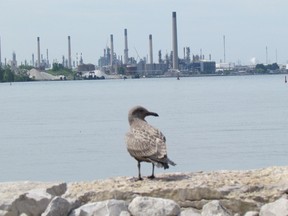Carbon capture 'key' for Sarnia industries, economic partnership says

Article content
Ontario’s decision to open the door to storing captured carbon emissions underground should let its industries – including Sarnia-area refineries and chemical plants – catch up with those already using the technology.
“This is a tool that is in everyone else’s toolbox,” said Shauna Carr of the Sarnia-Lambton Economic Partnership.
Natural Resources Minister Graydon Smith visited the Oil Museum of Canada in Oil Springs last month to talk about efforts to create a framework allowing development of large commercial carbon storage projects in Ontario.
That includes letting industries apply this year to begin testing and demonstrating small-scale underground storage projects on private land. Public consultations also are planned this year.
“Once the regulatory framework is in place, facilities located in Ontario can move closer to net zero through opportunities that are available through carbon capture,” Carr said.
“It’s absolutely key for the sustainability (of local industry) but it also encourages capital investment for new projects,” she said.
Ontario industries, including many in the Sarnia area, have been urging the province to allow carbon capture and storage for some time and in September, local industry representatives joined the economic partnership in a trip to Queen’s Park to make their case to the minister.
Ontario law barring carbon capture and storage dates to a previous Liberal government decision to end coal-fired electricity generation, Carr said. The province then didn’t want those generators to use carbon sequestration as a “loophole” to continue operating.
Carbon capture is no “silver bullet,” said Bob Masterson, chief executive of the Chemistry Industry Association of Canada. “It’s an important part of the portfolio of actions industry can take (and) it’s available in other jurisdictions.”
“It will be important to explore what the opportunities are and how much of a contribution it can make in the Sarnia area,” he said.
Ontario’s chemical industry, which generates about $26 billion a year, is nearly as big as Alberta’s but in recent years Western Canada has seen more new investment, he said.
Geology allowing underground storage of carbon isn’t found everywhere, but it does exist in Western Canada, Masterson said.
“Chemistry and energy companies here in Western Canada have been meeting some of the greenhouse gas compliance obligations through carbon capture for a couple of decades now,” he said.
The technology is also used on the U.S. Gulf Coast, which has a large concentration of petrochemical manufacturing.
Questions facing Sarnia-area industry include the economics, feasibility and size of reservoir available here, Masterson said.
“Those have to be resolved, but no one’s going to put the effort and money into it unless the government says this is an activity it’s willing to permit,” he said.
The province’s recent announcement signalled heavy industry that carbon capture is “something you can explore,” Masterson said.
“Ontario is still very, very early stages” compared to Alberta and the U.S. Gulf Coast, “where there’s a long-standing practice of this, and there’s legal and policy frameworks to make it happen,” he said.
With Canada’s price on carbon set to rise to $170 a tonne over the next few years, Masterson said heavy emitters in Ontario, like chemical, steel and cement companies, are asking themselves “what are your opportunities to take action to avoid those costs?”
Carbon capture “could potentially play a key role to help companies stay competitive,” he said.
Also, most Sarnia-area chemical producers are linked to global corporations with commitments to greenhouse gas reductions affecting where they make future investments, Masterson said.
“These global companies are only going to make those investments in jurisdictions . . . where they can do so at low carbon and contribute to their global corporate objectives,” he said.
The Sarnia area “has to be able to articulate how companies can invest there and contribute to their de-carbonization commitments,” Masterson said.
Sarnia officials also have set their sights on attracting low-carbon hydrogen investment and the ability to offer carbon capture is expected to be a factor.
“In Alberta you’re got a lot of hydrogen activity in place, but it’s almost all associated with carbon capture,” Masterson said.
Because carbon capture hasn’t been allowed in Ontario, the province missed out on federal net zero and hydrogen funds and credits in recent years, Carr said.
That’s “one more way we’ve been behind the eight ball” in competition with Alberta and other areas for new investments, she said.
“This is absolutely key to get Sarnia-Lambton to a level where we can access funds, grants and support the federal government has already had in place for a number of years,” she said.
The community is home to many of Ontario’s top greenhouse gas emitters, Carr said.
“All of these facilities are actively working towards de-carbonization and net-zero targets” but haven’t had access to one of the tools available in other locations, she said.
The partnership plans to continue supporting efforts to develop Ontario’s carbon capture framework, study the viability of the technology in the area and carry out pilot projects, Carr said.
Landon Tresise, with the Canadian Fuels Association, said by e-mail its members are encouraged by the province’s steps so far and its commitment to “environmentally responsible emissions reduction solutions.”
“This will help fuel suppliers to lower their carbon footprint, while producing and developing new alternate fuel options,” he said. “Each jurisdiction must look at these rules differently, and it’s important for the fuels sector that Ontario gets this right.
Postmedia is committed to maintaining a lively but civil forum for discussion. Please keep comments relevant and respectful. Comments may take up to an hour to appear on the site. You will receive an email if there is a reply to your comment, an update to a thread you follow or if a user you follow comments. Visit our Community Guidelines for more information.